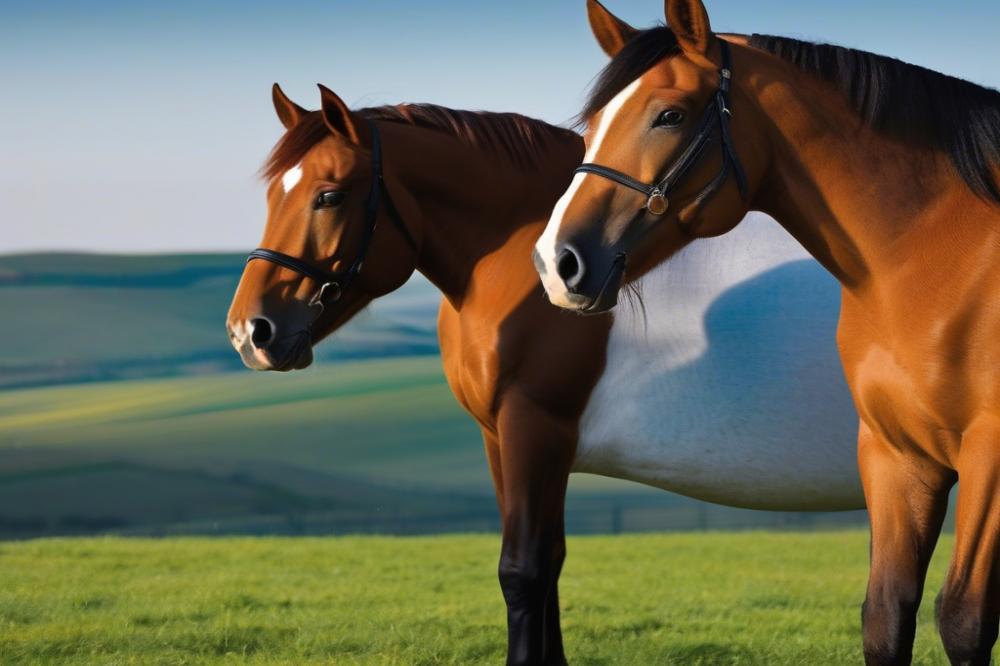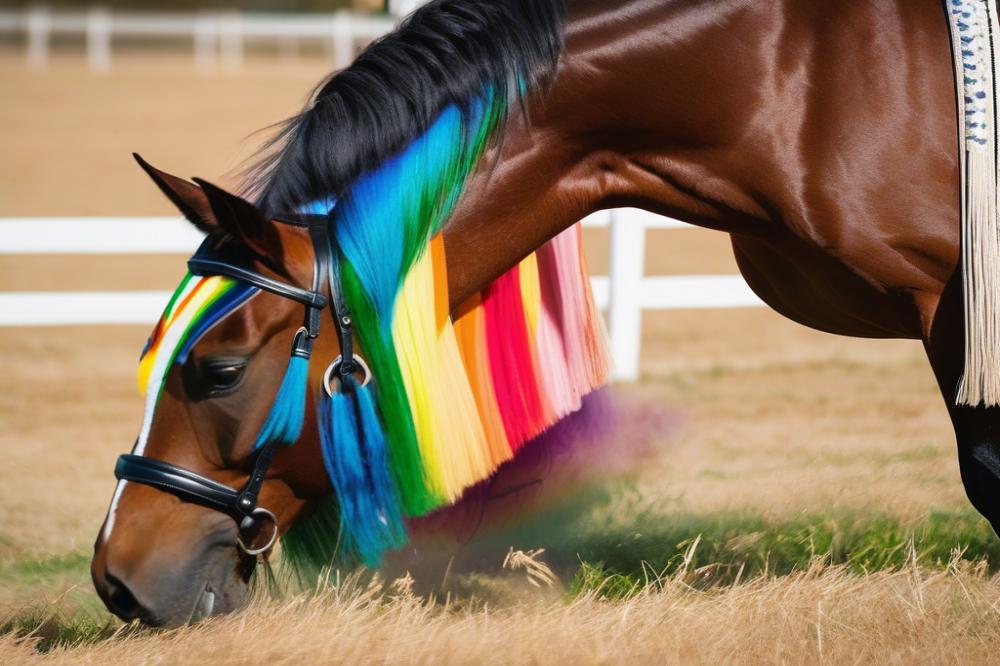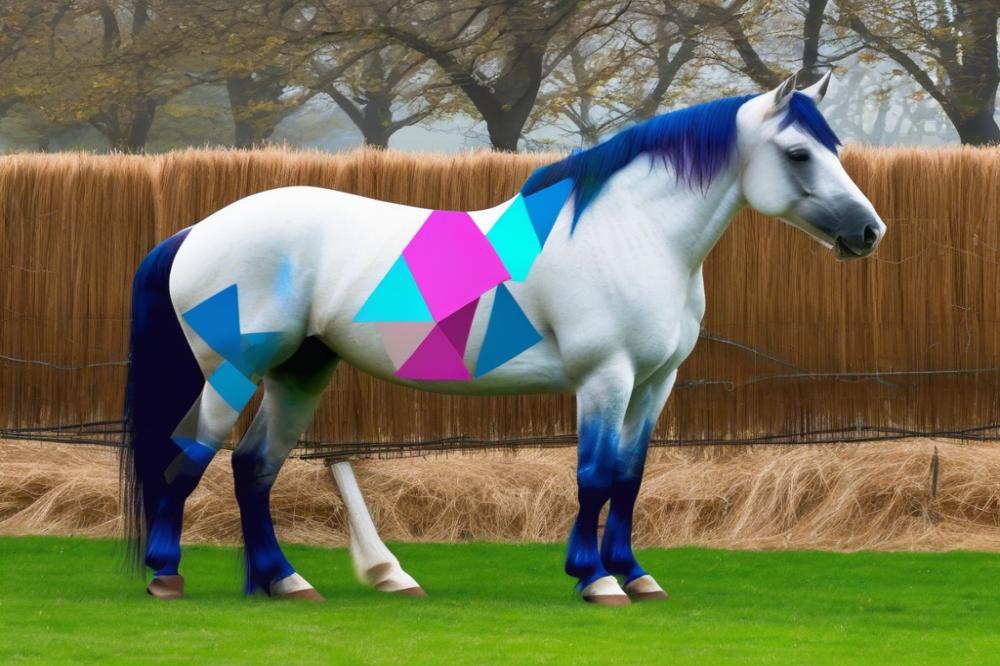Understanding Horse Color Perception
Have you ever wondered what colors horses actually see? It can be quite surprising! Unlike humans, horses have a different way of interpreting the world around them, especially when it comes to color. While we love a vibrant rainbow, horses see colors largely in shades of blue and yellow. Reds and greens often appear as gray or brownish tones to their curious eyes. This unique perspective plays a big role not only in their daily lives but also in how we handle horse care and training.
The Importance of Knowing Horse Color Preferences

When you’re out there working with your horse, understanding horse senses can truly make a difference. Imagine a horse that finds a bright red blanket alarming or a shiny, reflective surface confusing! We might find certain colors appealing, but horses could be frightened by them or simply indifferent. Recognizing how colors affect horse behavior allows owners and trainers to create a more comfortable environment for these majestic animals.
Why This Matters
Caring for a horse means paying attention to many details. Knowing which colors horses dislike can impact everything from the design of their gear to the colors we choose for protective equipment and toys. Think about it—would you want to wear a shirt that makes you feel uneasy? The same goes for horses! Additionally, understanding equine vision can help trainers develop better strategies during training sessions. Picture a scenario where a horse spooks at a particular color; that distraction can lead to accidents. Better to avoid the colors that make them jumpy, right?
Putting It All Together
This article aims to unravel the mysteries of what colors horses actually hate, steering clear of subjective opinions and quirky myths. We’ll explore this topic, comparing it even to the peculiar speed of a moose vs horse speed. Just as the breeds of horses UK showcase diversity, so too does the world of colors that horses might find less than appealing. Join us on this colorful journey!
Understanding Horse Color Perception

Basic principles of color vision in horses
Horses see the world differently than we do. Their eyes are built for distance, not close detail. They can pick out movements better than colors. Horses have dichromatic vision. This means they see two color wavelengths. They mainly perceive blues and yellows but struggle with reds. As a result, bright colors often look dull to them.
Comparison between horse vision and human vision
Have you ever noticed how vibrant colors pop in our world? Well, humans have trichromatic vision. That allows us to differentiate between red, green, and blue. Our horses, on the other hand, lack the ability to see red. Imagine being at a party where the DJ only plays two genres of music while you love all types. That’s a bit like how horses experience colors compared to us.
Key differences in color spectrum perception
One of the interesting aspects of equine behavior revolves around how they interact with various colors. For instance, green fields may look lush and inviting to them. But bright red objects? They probably appear grayish or even brownish. That’s not what you want in your horse care, especially when training. Using colors they dislike, like the darkest shades, can potentially make them feel uneasy.
The different visual spectrum is a cornerstone of horse training. Understanding how your horse sees can help guide your exercises. Horses may have a strong reaction to colors that confuse them. This confusion might lead to behaviors that could complicate your riding experience. When it comes to horse senses, perception of color adds a unique twist to interactions.
So, when choosing gear or decor, think about your horse’s vision. Would your horse prefer a calm blue blanket over a chaotic crimson one? Likely! Keeping colors in mind helps you build trust and comfort with your equine friend. That tiny detail could make big changes in your training sessions.
Research on Colors Horses Dislike

When looking into what colors horses might dislike, researchers have had some interesting findings. Many studies focused on how different colors affect equine behavior. Horses, being prey animals, are particularly sensitive to their environment. Their vision offers unique perspectives on various colors.
One study suggested that horses show a notable reaction to the color yellow. This bright hue can induce stress or avoidance behaviors. Imagine a big, bright school bus sneaking up on an unsuspecting horse. It’s enough to send anyone running! Another color that’s often mentioned is white. Brightness can cause anxiety, especially if a horse isn’t used to it.
Of course, not all horses react the same way. They have their own personalities, just like humans. What one horse finds alarming, another might not bat an eye at. With their exceptional horse senses, they often evaluate situations based on past experiences.
Sometimes colors related to human objects can trigger concerns. For instance, horses can be wary of things like flags or even certain types of clothing. During training sessions, this can result in a horse acting skittish or jittery. Trainers need to pay close attention to their surroundings and what might be causing unease.
Then there are anecdotal experiences shared by horse owners. Many claim their horses can be alarmed by bright patterns, like polka dots or stripes. It seems a bit funny at first, but a horse’s cheeseburger-patterned blanket might just send it galloping away. These reactions speak volumes about equine vision and perception.
When caring for horses, understanding their reactions to colors helps in creating a calm environment. Training can also benefit from knowing these tendencies. A little insight into what colors might upset them could go a long way in building a stronger bond.
While definite answers are hard to pin down, each observation provides useful information about our equine companions. The interplay between horse behavior and colors presents an exciting area for exploration. Someone once said, “A horse will remember.” Understanding their dislikes may improve horse care techniques down the line.
The Role of Color in Horse Training
Impact of color perception on training methods
Have you ever noticed that some horses seem to spook at certain colors? It turns out that horses can perceive a range of colors, but their vision is different from ours. This difference can sometimes lead to unexpected reactions during training. For instance, a horse may shy away from objects with vivid shades, thinking they are threats. Recognizing this aspect of equine behavior can help trainers adjust their methods. People who work with horses can modify the environment to ease anxiety.
Using color to communicate with horses
Color can play a significant role in how humans communicate with horses. Trainers can use specific colors to signal certain actions or emotions. For example, using bright colors for equipment can attract attention, while softer colors can help calm a nervous horse. Imagine a rider wearing a bright orange shirt. That might just set a horse on edge! Alternatively, wearing muted tones can create a more peaceful atmosphere. Working with horses means understanding their senses, including how they respond to color.
Strategies for minimizing negative responses to certain colors
Managing a horse’s reaction to color requires some creativity. One helpful strategy is to gradually expose the horse to various colors in a controlled setting. Start with something simple, like a colorful blanket or brush. This way, you can observe their behavior and reactions without overwhelming them. Another idea is to pair the negative color with something pleasant, like treats or praise. This positive reinforcement can help shift their focus away from the scary color. Remember, building trust and understanding takes time with these magnificent animals!
Environmental Factors Influencing Color Perception
How Lighting and Surroundings Affect Color Visibility
Have you ever noticed that colors can look different depending on where you are? Imagine standing under a bright sun and then walking into a shadowy barn. Lighting plays a huge role in how we see colors, and it’s no different for our equine buddies. Horses have a unique way of detecting light, which means they might view colors differently based on the time of day or the type of light. During bright daylight, colors pop! But when it’s gloomy, those same colors can seem dull or even hidden.
Surroundings also matter. A field full of green grass can shift colors due to nearby flowers or trees. This mash-up can confuse a horse’s vision. They depend on their surroundings to make sense of the world. If the color they see is surrounded by other colors, it might look completely different. It’s like trying to find the blue crayon in a box of mixed colors—it could blend in or stand out, depending on the other shades around it.
Relationship Between Color Perception and Horse Behavior in the Environment
How does this affect equine behavior? Horses react to their environment based on what they see. If a color seems unfamiliar or strange, it could frighten a horse. Take, for example, a bright orange barrel in the middle of a green pasture. It might draw attention and cause a horse to spook. An unexpected splash of color can lead to a quick move away from it.
In training, understanding how horses perceive colors is essential. Trainers can utilize this knowledge to create a safe and comfortable space for their animals. If we know that certain hues might trigger anxiety, it makes sense to avoid those in areas where horses spend time. It’s all about keeping equine behavior on the calm side.
Horse senses are finely tuned. They rely heavily on vision for spotting danger and navigating their environment. Color is just one part of the picture. Factors like movement and shapes also play vital roles. A horse might be more concerned about a rustling bush than a bright pink fence. Knowing how these elements interlink helps caregivers and trainers create positive experiences for their horses.
In the world of horse care, being mindful of color isn’t just a fun fact; it’s a real deal. Understanding the relationships between colors, environments, and horse behavior can lead to better training methods and happier horses. If we take the time to think about what our ponies perceive, we can build a bond that goes beyond just riding. After all, a little consideration goes a long way in making friends with these magnificent creatures.
Practical Implications for Horse Owners
Choosing Appropriate Colors for Barn, Equipment, and Apparel
When it comes to colors, horses can be quite picky. They don’t see the world like we do. Bright, flashy colors might grab our attention, but many can scare a horse. Dark colors like navy or deep green are often better choices. These hues tend to create a calmer atmosphere. Likewise, think about the equipment you use. A bright yellow saddle pad could send some horses into a tizzy. Opt for softer, more muted colors that don’t startle them.
Don’t forget the barn! Dark colors within the stable can help create a soothing environment. In contrast, a bright red paint job could make a horse feel jittery. Some horses may react negatively to these bold colors. So, when you’re shopping for paint or decor, choose wisely.
Advice on Introducing Horses to Different Colors
Introducing your horse to new colors should be done carefully. Take it slow, just like teaching a young child. Start with items that aren’t too flashy. A new blanket? Introduce it gradually, letting your horse sniff it first. You can hang it near their stall for a few days. Allow them to familiarize themselves with the sight and scent.
After that, try putting it on when they seem relaxed. Remember, every horse is different. While some might accept change quickly, others may take a while. Patience is vital during this process. Offering treats can create a positive connection. Soon enough, they may even look forward to the new gear.
Creating a Positive Environment for Horses
Crafting a cozy space for your horse is essential for their well-being. Think about placing calming images or objects around the barn. Soft colors on the walls can promote a peaceful vibe. Keep in mind that horses are incredibly sensitive to their surroundings. A chaotic or overly bright space can lead to stress, affecting equine behavior.
Keeping their environment tidy and safe is just as crucial. A cluttered area can cause anxiety. Just imagine trying to relax in a messy room! Adding plants or natural elements can also enhance the ambiance. This helps horses feel more secure, reducing stress levels. Each small detail adds up to a more harmonious atmosphere.
Consider the power of sound, too. Soft music can soothe some horses. Others might prefer silence while they graze. Adjusting the environment should fit their individual preferences. Incorporating these ideas into your horse care routine will nurture a serene experience. Every horse deserves a cozy home where they can thrive.
Future Directions in Research on Horse Color Perception
Many horse enthusiasts wonder about how their equine friends perceive colors. Have you ever noticed how your horse reacts to certain colors? That reaction is part of a larger picture of equine behavior. Understanding horse senses could open doors to better care and training methods.
Potential Areas for Further Study
There’s still a lot to unearth about how horses view the world. One interesting direction is examining how different colors affect a horse’s mood. This could lead to innovative training techniques tailored to their preferences. Moreover, researchers might delve deeper into how specific colors impact their performance in various activities.
Another area could involve studying the effects of colors in different environments. Do bright, bold colors in a stable change a horse’s anxiety levels? Asking questions like this can yield important insights. It’s fascinating to think that a simple color might calm a nervous horse or get them a bit more spooked.
Importance of Ongoing Research in Improving Horse Well-Being
Continuing this kind of research is crucial. As we learn more about equine vision, we can enhance horse care practices. A happier horse is typically a more cooperative horse. Imagine a world where training methods are based on color preferences! It could feel like a magical breakthrough.
Additionally, understanding how colors influence a horse’s behavior can improve their living conditions. Horses need environments where they feel safe and relaxed. Who wouldn’t want their majestic companion to be at ease? Innovations in this area could lead to changes in barn design or gear selection. The right colors might make the difference between a horse that flies through competition and one that remains hesitant.
Ultimately, every bit of knowledge we gain helps us better understand our four-legged friends. As we strive to improve equine training and care, new studies will shed light on previously overlooked aspects of horse behavior. Research can be the key to unlocking better relationships between humans and horses.
Wrapping It All Up
We’ve taken quite the journey exploring what colors horses might dislike. As we’ve seen, horses perceive colors differently than we do. They might see colors like yellow and green clearly, but red can be confusing for them. Imagine wearing glasses that turn the world into a funny, mismatched puzzle! That’s how your equine friend sees things. Just like people have preferences, it seems fair to say that horses do too.
Color understanding in caring for these majestic creatures can have significant effects. For instance, choosing appropriate colors for blankets or tack could help reduce anxiety. If a horse is more startled by a bright red saddle pad than a calm blue one, why risk it? It’s like picking a book cover; would you rather choose a friendly one, or one that looks like it could jump out at you in the middle of the night?
Picture this: A draft horse versus a quarter horse, both wearing bright pink. While one might strut around acting like a superstar, the other might be plotting an escape. That’s why knowing what colors may irk your horse is essential. It’s not just about aesthetics; it’s about comfort and confidence.
Furthermore, when it comes to horse halter types, color choices also matter. A well-chosen color can help emphasize your horse’s best features while keeping their mood light. After all, a happy horse is a healthy horse!
Let’s not forget—the bond between horse and rider is a beautiful dance. Understanding the nuances of what colors please or disturb our equine companions can strengthen that relationship. Ultimately, a little color awareness can go a long way. The next time you’re shopping for gear, take a moment to think about your horse’s perspective. They just might appreciate it more than you think!



